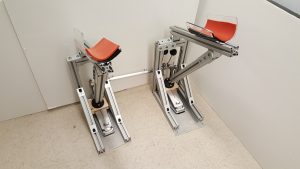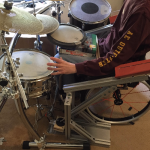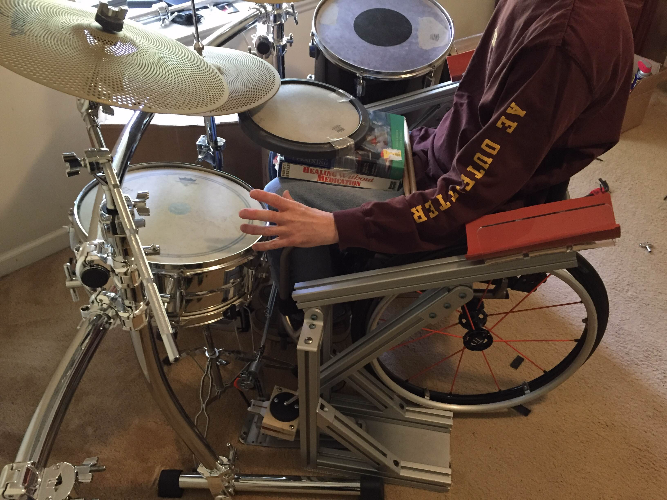Designers: Kevin Fu, Jason Wang, Luke Choi
INTRODUCTION
Our client is an adult male who has experienced a complete spinal cord injury at the T6 vertebrae, located in the mid to upper back. This has resulted in the complete loss of sensation and motor control of the legs and he has minor limitations in using his core muscles [1]. Because of his injury, our client uses a wheelchair to assist in daily life. The client is independent and has a strong, coordinated upper body, but he still faces difficulties with tasks that require the use of his legs and wheelchair accessibility. Our client is a talented drummer, but he cannot play the bass drum, which is conventionally played by a foot pedal and is a key element in a drum rhythm.
Currently, there is no commercial device that would enable our client to play the bass drum without using his legs. Some musicians have made custom devices, such as modifying a drum set to have an electric drum pad that plays the bass drum with his hands [2]. This solution still limits the ability of the drummer to play the full drum kit in that the hands are now occupied with another piece. Also, our client does not like the lack of haptic feedback of an electric drum pad.
Our goal was to develop a device that will assist our client in playing the bass drum without the use of his legs. The device is accessible whether or not the client decides to play in his wheelchair. It is as portable as a standard drum kit, only needing placement and slight adjustments before use. The client is able to operate the device solely from his upper body and requires only light physical exertion. The device allows for the user to feel a haptic feedback that gives the natural feeling of maintaining a sense of rhythm and control. We aim to make this device as intuitive and as effective as playing the bass drums with the classic foot pedal.
STATEMENT OF IMPACT
Our client is simply excited to play the drums in a similar fashion as before his accident as part of his hobby. As stated by our client, “This device should be very effective to do what it was designed to do: i.e., to allow me to play the drum set again with the full use of the bass drum pedals.” Being able to play the drums will provide a number of benefits to the client, through factors such as mental health, community interaction, and physical fitness- all of which will greatly increase the standard of living of our client.
TECHNICAL DESCRIPTION

Figure 1: The floating pedal system consists of two levers. When the user presses down on a lever with his forearms, the lever action presses down on the pedals, striking the bass drum
The Floating Pedal System works by having the client’s elbow push down a rod connected to a bass pedal. The fundamental design of this device is a simple lever connected to a linkage arm. Force from the user’s elbow presses onto the lever arm, which is attached to a second arm that transfers the force to a drum pedal. It works similarly to a mechanical printing press, in which the lever handle transfers a downward motion into a concentrated print area. Instead of a print page, our device concentrates force to a foot pedal. The device’s design focuses on user playability, mechanical framework, and connecting interfaces.
- User control
The direction of the force from the user was determined through physical testing and personal interview, leading to the conclusion that a hybrid motion would work best for force transfer and comfort. A hybrid motion is characterized by a combination of pushing down with the elbow along with pulling it towards the torso. A discussion with current Occupational Therapy students concluded that this type of motion would have no adverse effects on the client’s long-term shoulder health relative to regular drum playing movements [4]. An emphasis on the direction of motion in the design process is key to building the most comfortable and intuitive device for the user. User experience based design addresses not only a way to drive a foot pedal, but to drive it as a part of the main drum set.
- Mechanical Framework
The main lever arm is hinged on a frame that represents the main pivot point of the system. This frame was built of T-slotted aluminum beams that provide a rigid and lightweight base. A drum pedal rests upon a small platform that the frame is bolted down to. This conformation utilizes the weight of the pedal and the bass drum to maintain stability and counterbalances the forces that lift the pedal off the ground while in use. The linkage arm connects to the lever and clamps to the bass pedal.
- Connecting Interfaces
The joints that connect the lever arm to the frame and the lever to the pedal pushing arm are hinge joints. These were used to maintain a stable rotating frame while also having a small amount of lateral flexibility for slight hybrid movements. The pedal push arm to the pedal is connected by a ball and socket joint, which dissipates lateral stresses while also transferring the main pushing force. The surface of the base plate and the bottom of the pedals were laid with heavy duty Velcro to prevent lateral slipping. Additionally carpet gripping tape is laid between the bottom of the device and the carpet it stands on to provide further stability.
REFERENCES
- Spinal Cord Injuries, U.S. National Library of Medicine, June 2015, Date Accessed: November 8, 2015, https://www.nlm.nih.gov/medlineplus/spinalcordinjuries.html
- Welch, Chris. Disable Musician Reinvents the Drums. CNN. June 9, 2010. http://www.cnn.com/2010/LIVING/06/09/paralyzed.drummer.invention/
- Spinal Life Australia, March 2009. Image link: https://www.spinal.com.au/wp-content/uploads/2009/03/spinal.jpg



University Operator: (919) 962-2211 | © 2024 The University of North Carolina at Chapel Hill |